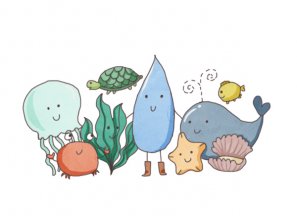The Mangrove Forest
Did you know that mangrove forests, or mangals, are also called “survivors?” With root systems that grow above water levels, these halophytes can thrive in conditions including extreme heat, high salinity, and waterlogged mud, whereas other plants cannot survive in these environments. Moreover, mangrove forests make up a distinctive and diverse biome, with many species that are unique to this saline habitat coexisting and cooperating with one another!

1. What is a mangrove forest?
A mangrove forest is defined as a group of shrubs and small trees that grows in coastal and saline areas. There are about 80 different types of mangrove trees around the world.
Halophytes and the mangrove forests[1]
Halophytes are plants that can survive in saline or brackish water habitats with low oxygen and freshwater levels. Each halophyte has an ultra-filtration system that excludes sodium salts from the rest of the plant, as well as specialized roots that allow for better air absorption in inundated areas or during high tides. To limit water loss, some species can restrict the opening of their stomata (pores of leaves) or vary the orientation of the leaves to avoid the evaporation resulting from the intense midday sun.
.jpg) To propagate the species, halophytes produce seedling that is termed propagules. These propagates are extremely versatile and adaptable to new environments, and they only drop into the water surrounding the halophytes when they are sufficiently mature. Seedlings with low density can be transported great distances before arriving at a favorable environment, while others with higher densities sink into the muddy banks and root. Since these propagules can photosynthesize and produce their own food, they can remain dormant for up to a year before rooting in suitable conditions.
To propagate the species, halophytes produce seedling that is termed propagules. These propagates are extremely versatile and adaptable to new environments, and they only drop into the water surrounding the halophytes when they are sufficiently mature. Seedlings with low density can be transported great distances before arriving at a favorable environment, while others with higher densities sink into the muddy banks and root. Since these propagules can photosynthesize and produce their own food, they can remain dormant for up to a year before rooting in suitable conditions.
Mangrove forests can only grow in equatorial, tropics, and sub-tropics regions, because their cold tolerance is too low.
These forests cover about 137,000 sqkm, an area greater than the size of Bangladesh. They can be found in 123 countries, but the majority of these mangals (75% of total area) are concentrated in 15 countries. Indonesia alone accounts for a quarter of mangals worldwide. Other countries with a notable density of mangrove forests include Australia, Brazil, and Mexico.[2]
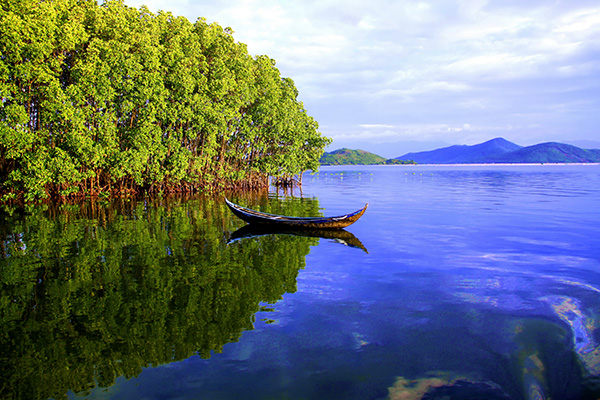
The Mangrove Forest in Vietnam. Photo taken by Hoang Trong Dung from the contest "One Ocean, One Future" (U.S. Embassy, 2016)
There are 29 cities and provinces in Vietnam with mangals, from Mong Cai to Ha Tien. The forests are mostly situated in the South, especially in Ca Mau and the Cuu Long delta. Northern mangals are smaller and less prominent.
Among 37 species of halophytes found in Vietnam, most of them live in the Cuu Long delta. Most notable are the mangals in U Minh (Ca Mau) and the Sac Forest in Can Gio in Ho Chi Minh City, both of which have been declared as biosphere reserves by UNESCO.[3]
Over the last 5 decades, due to socioeconomic development in coastal regions, Vietnam has lost 67% of its mangrove area compared to that in 1943. Over the past 22 years (1990-2012), the rate of mangrove loss is 1.7 times more than the period of 47 years earlier (1943-1990)
According to The state of national environment reports from 2011-2015, 56% of the total area of mangrove forests in Vietnam is newly planted, with lower quality than mangrove primary forests in size, height, and species diversity. [4]
The ecosystem of mangrove forests

Mangrove forests provide many species with both their habitat and sustenance [5]: many wild animals reside here, such as alligators, tigers, deers, monkeys, bees, and birds, (especially migratory birds like cranes and pelicans) [6]. Underneath the intricate webs of mangrove roots, organisms proliferate, especially those in the early stages of life; lobsters and shrimps dig out homes in the mud, and mangrove crabs live off of the mangrove leaves. The waste in turn enriches the mangal mud for bottom feeders..jpg)
The forests improve water quality in coastal area by stabilizing concentrations of both organic and inorganic substances, as well as removing and recycling both nutrients and pollutants. More specifically, halophytes can filter out pollutants from the coast before these chemicals reach delicate marine biomes such as coral reefs.[7] The complex root system of these halophytes also slows down the water flow, allowing for the settling of toxic waste bound to sediment particles, and these particles can then be removed from the ecosystem. Due to the high cost of building a water treatment plant, there is speculation that mangroves, when planted at polluted sites, can serve as a cost-effective alternative to detoxify the environment.[8]
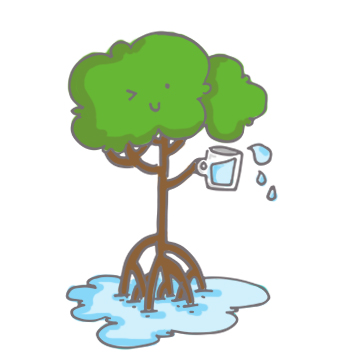
Furthermore, mangals protect the coast from erosion and tidal waves with their massive systems of roots and branches, and they also increase the total landmass by allowing fertile silt to be deposited in the banks. At riverside and seaside sites where these biomes have been deforested, erosion happens significantly faster than before, when the forests were in place.[9]
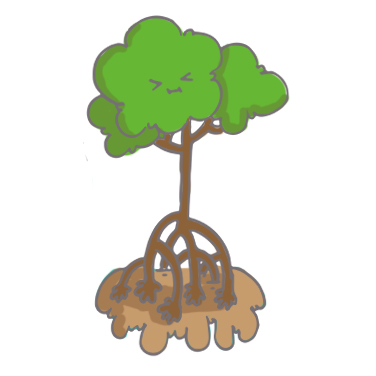
Moreover, these forests also serve as carbon sinks and remove carbon dioxide from the atmosphere. Compared to other types of forests, mangals can remove five times as much carbon dioxide at the same area, according to a report from professors at the Center for International Forestry Research.[10] An example for the efficiency of mangals in cleaning the environment can be found in Indonesia, the country with the greatest area of land covered with mangrove forest: the total amount of carbon dioxide removed from the air in a year is equal to the volume of carbonic emissions from cars!
Finally, mangrove forests protect and improve the life of people who live near this biome. Many necessary resources like seafood, coal, wood, flax, and dyes can all be found in mangals, and the forests can also serve as tourist destinations, improving the economy of the region..jpg)
Furthermore, they shield settlements from natural disasters like rainstorms, floods, and tsunamis. This is exemplified by the case of Naluvedapathy in Tamil Nadu, India: the damage done to the village after a tsunami was limited, thanks to their Guinness-certified mangal with eighty thousand halophytes.
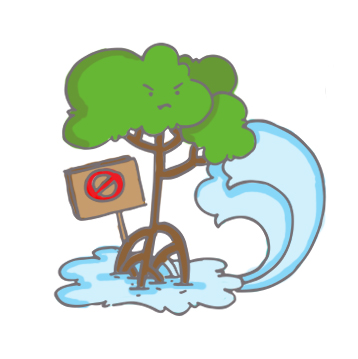
2. Threats to mangrove forests
Due to the relative lack of knowledge about the role that man gals play in the environment, many forests around the world have been completely harvested in the past. Even now, as their importance becomes common knowledge, they are still disappearing at a worrisome speed: in the last decade, at least 35 percent of mangals worldwide have been destroyed, a deforestation rate higher than that of tropical forest.
Although there have been efforts to increase the size of mangrove forests, these increased areas are not enough to compensate for the ongoing threat of deforestation.
3. Cause of deforestation
Human activity is the greatest threat to mangals.
From cutting down halophytes for wood, to using the land for shrimp farms and harming the root systems by foraging near young trees, many people are destroying the forests.
Furthermore, these forests can also be harmed by toxic chemicals, such as industrial waste from factories, fertilizers, and herbicide. These chemicals flow downstream and collect at mangals in high concentrations, which severely disrupts the balance of the biome.[11]
Climate change and rising sea levels also contribute to the diminishing size of these forests. When the area becomes too flooded or too saline, halophytes cannot survive, and if the propagules cannot root at higher altitudes due to dikes or other obstacles, mangrove forests cannot survive on.
4. What can we do?

- Firstly, take note when you're travelling or foraging for resources in mangals to make sure that you do not accidentally break the roots and branches of halophytes
- Keep the water clear! - Do not litter or dispose of chemicals into rivers and oceans, because the toxic garbage will drift to mangrove forests.
- Take part in events where you can plant halophytes - the more halophytes are planted, the better the environment and resource yield from mangals.

- Spread the word - talk about the benefits of these forests and the ways that we can protect them - the more people who are aware, the more effective our conservation efforts would be
- Manage and oversee the harvesting of resources in these biomes - notify your local authorities if deforestation and unsustainable harvesting happens.
